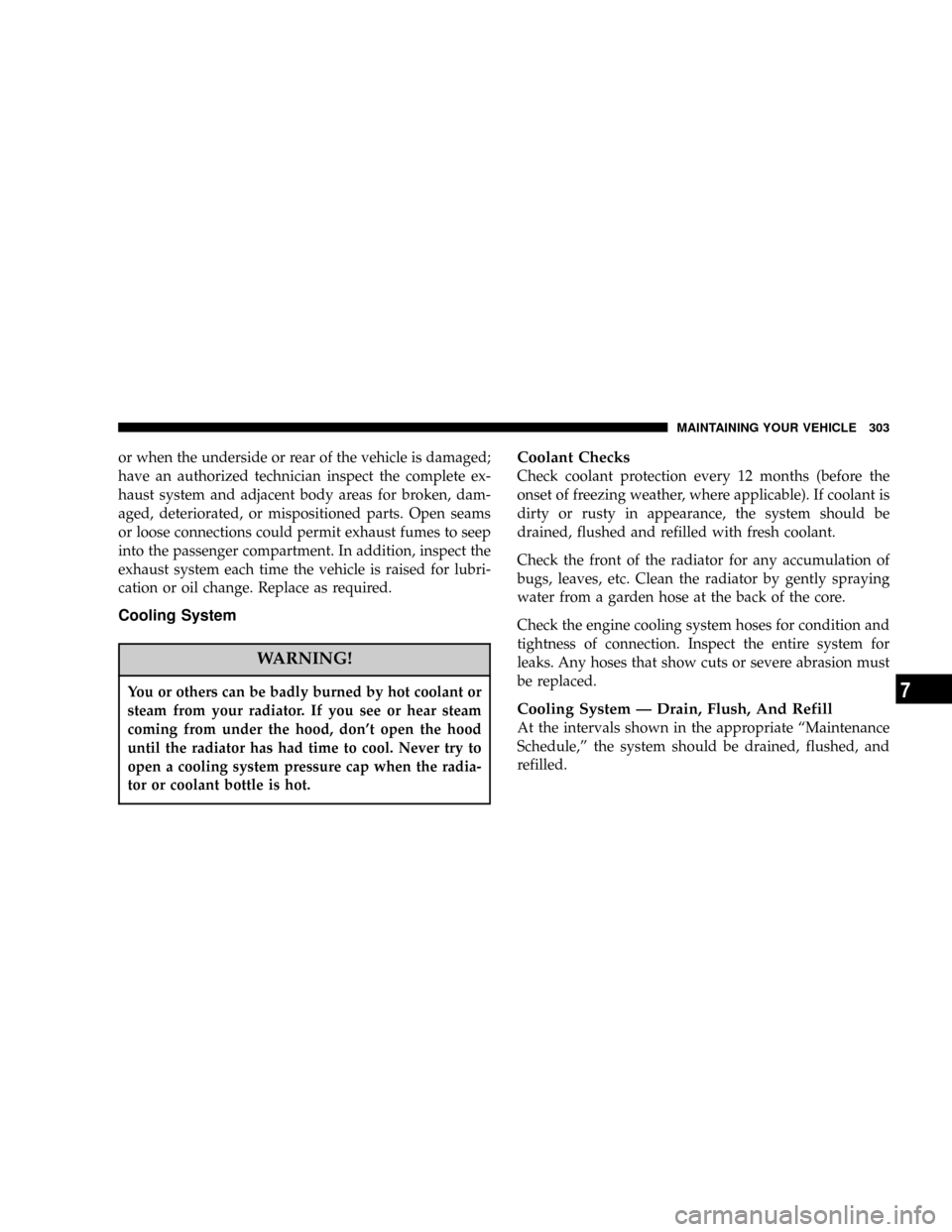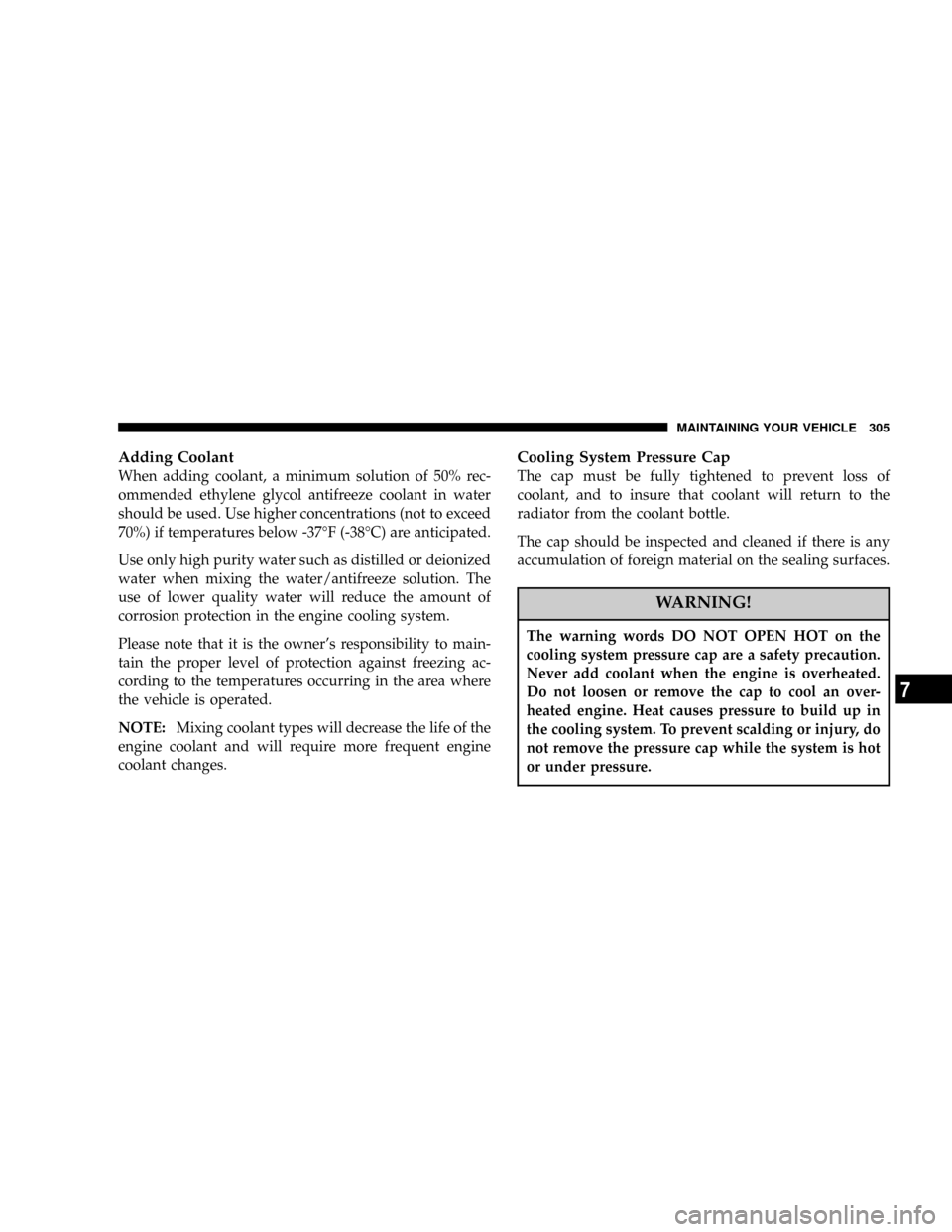2004 JEEP LIBERTY Coolant pressure
[x] Cancel search: Coolant pressurePage 70 of 374

Defrosters
Check operation by selecting the defrost mode and place
the blower control on high speed. You should feel the air
directed against the windshield.
Safety Checks You Should Make Outside The
Vehicle
Tires
Examine tires for excessive tread wear or uneven wear
patterns. Check for stones, nails, glass, or other objects
lodged in the tread. Inspect for tread cuts or sidewall
cracks. Check wheel nuts for tightness and tires (includ-
ing spare) for proper pressure.
Lights
Have someone observe the operation of all exterior lights
while you work the controls. Check turn signal and high
beam indicator lights on the instrument panel.
Fluid Leaks
Check area under vehicle after overnight parking for fuel,
coolant, oil or other fluid leaks. Also, if gasoline fumes
are detected, the cause should be located and corrected
immediately.
70 THINGS TO KNOW BEFORE STARTING YOUR VEHICLE
Page 303 of 374

or when the underside or rear of the vehicle is damaged;
have an authorized technician inspect the complete ex-
haust system and adjacent body areas for broken, dam-
aged, deteriorated, or mispositioned parts. Open seams
or loose connections could permit exhaust fumes to seep
into the passenger compartment. In addition, inspect the
exhaust system each time the vehicle is raised for lubri-
cation or oil change. Replace as required.
Cooling System
WARNING!
You or others can be badly burned by hot coolant or
steam from your radiator. If you see or hear steam
coming from under the hood, don't open the hood
until the radiator has had time to cool. Never try to
open a cooling system pressure cap when the radia-
tor or coolant bottle is hot.
Coolant Checks
Check coolant protection every 12 months (before the
onset of freezing weather, where applicable). If coolant is
dirty or rusty in appearance, the system should be
drained, flushed and refilled with fresh coolant.
Check the front of the radiator for any accumulation of
bugs, leaves, etc. Clean the radiator by gently spraying
water from a garden hose at the back of the core.
Check the engine cooling system hoses for condition and
tightness of connection. Inspect the entire system for
leaks. Any hoses that show cuts or severe abrasion must
be replaced.
Cooling System Ð Drain, Flush, And Refill
At the intervals shown in the appropriate ªMaintenance
Schedule,º the system should be drained, flushed, and
refilled.
MAINTAINING YOUR VEHICLE 303
7
Page 305 of 374

Adding Coolant
When adding coolant, a minimum solution of 50% rec-
ommended ethylene glycol antifreeze coolant in water
should be used. Use higher concentrations (not to exceed
70%) if temperatures below -37ÉF (-38ÉC) are anticipated.
Use only high purity water such as distilled or deionized
water when mixing the water/antifreeze solution. The
use of lower quality water will reduce the amount of
corrosion protection in the engine cooling system.
Please note that it is the owner's responsibility to main-
tain the proper level of protection against freezing ac-
cording to the temperatures occurring in the area where
the vehicle is operated.
NOTE:Mixing coolant types will decrease the life of the
engine coolant and will require more frequent engine
coolant changes.
Cooling System Pressure Cap
The cap must be fully tightened to prevent loss of
coolant, and to insure that coolant will return to the
radiator from the coolant bottle.
The cap should be inspected and cleaned if there is any
accumulation of foreign material on the sealing surfaces.
WARNING!
The warning words DO NOT OPEN HOT on the
cooling system pressure cap are a safety precaution.
Never add coolant when the engine is overheated.
Do not loosen or remove the cap to cool an over-
heated engine. Heat causes pressure to build up in
the cooling system. To prevent scalding or injury, do
not remove the pressure cap while the system is hot
or under pressure.
MAINTAINING YOUR VEHICLE 305
7
Page 307 of 374

moisture from rain, snow, or high humidity accumulat-
ing on the radiator and being vaporized when the
thermostat opens, allowing hot water to enter the radia-
tor.
If an examination of your engine compartment shows no
evidence of radiator or hose leaks, the vehicle may be
safely driven. The vapor will soon dissipate.
²Do not overfill the coolant bottle.
²Check coolant freeze point in the system.
²If frequent coolant additions are required, or if the
level in the recovery bottle does not drop when the
engine cools, the cooling system should be pressure
tested for leaks.
²Maintain coolant concentration to 50% ethylene glycol
antifreeze (minimum) in water for proper corrosion
protection of your engine that contains aluminum
components.
²Make sure that the radiator and coolant bottle hoses
are not kinked or obstructed.
²Do not change the thermostat for summer or winter
operation. If replacement is ever necessary, install
ONLY the correct type thermostat. Other designs may
result in unsatisfactory cooling performance, poor gas
mileage, and increased emissions.
Hoses and Vacuum/Vapor Harnesses
Inspect surfaces of hoses and nylon tubing for evidence
of heat and mechanical damage. Hard or soft spots,
brittle rubber, cracking, tears, cuts, abrasions, and exces-
sive swelling indicate deterioration of the rubber.
Pay particular attention to the hoses nearest to high heat
sources such as the exhaust manifold. Inspect hose rout-
ing to be sure hoses do not touch any heat source or
moving component that may cause heat damage or
mechanical wear.
MAINTAINING YOUR VEHICLE 307
7
Page 331 of 374

²Off-road or desert driving.
NOTE:Most vehicles are operated under the conditions
listed for Schedule ªB.º
Second is ScheduleªAº. It is for vehicles that are not
operated under any of the conditions listed under Sched-
ule ªB.º
Use the schedule that best describes your driving condi-
tions. Where time and mileage are listed, follow the
interval that occurs first.
CAUTION!
Failure to perform the required maintenance items
may result in damage to the vehicle.
At Each Stop for Fuel
²Check the engine oil level about 5 minutes after a fully
warmed engine is shut off. Checking the oil level while
the vehicle is on level ground will improve the accu-
racy of the oil level reading. Add oil only when the
level is at or below the ADD or MIN mark.
²Check the windshield washer solvent, add as required.
Once a Month
²Check the tire pressure and look for unusual wear or
damage.
²Inspect the battery, and clean and tighten the terminals
as required.
²Check the fluid levels of the coolant reservoir, brake
master cylinder, and transmission, and add as needed.
²Check all lights and all other electrical items for correct
operation.
MAINTENANCE SCHEDULES 331
8
M
A
I
N
T
E
N
A
N
C
E
S
C
H
E
D
U
L
E
S
Page 358 of 374

Adding Washer Fluid..................... 204
Air Cleaner, Engine...................... 297
Air Conditioner Maintenance............... 299
Air Conditioning........................ 200
Air Conditioning Controls...............200,201
Air Conditioning, Operating Tips............ 202
Air Conditioning Refrigerant............... 300
Air Conditioning System.................. 200
Air Filter.............................. 297
Air Pressure, Tires....................... 249
Airbag................................ 46
Airbag Deployment....................... 55
Airbag Light.......................51,58,157
Airbag Maintenance....................... 57
Airbag, Window......................... 47
Alarm................................ 28
Alarm, Panic............................ 25
Alignment and Balance................... 253
Alterations/Modifications, Vehicle............. 8Antenna, Satellite Radio................... 193
Antifreeze (Engine Coolant)................ 326
Anti-Lock Brake System................... 234
Anti-Lock Warning Light.................. 152
Appearance Care........................ 315
Arming Theft System...................... 28
Auto Down Power Windows................ 33
Automatic Dimming Mirror................. 76
Automatic Door Locks..................... 21
Automatic Transmission................216,311
Adding Fluid......................... 312
Fluid and Filter Changes................. 311
Fluid Level Check...................... 311
Fluid Type........................... 311
Gear Ranges.......................... 217
Shifting............................. 216
Special Additives...................... 312
Torque Converter...................... 221
Auxiliary Electrical Outlet.................. 133
358 INDEX
Page 360 of 374

Catalytic Converter...................... 295
Caution, Exhaust Gas...................... 68
CD Changer......................164,171,182
CD Player...............167,169,174,180,183,186
CD Player Maintenance................... 197
Cellular Phone........................78,198
Chains, Tire............................ 257
Changing A Flat Tire..................... 274
Charging System Light.................... 153
Chart, Tire Sizing........................ 241
Child Restraint......................58,63,65
Child Restraint Tether Anchors.............62,63
Child Safety Locks........................ 22
Cigar Lighter........................... 135
Climate Control......................... 198
Clock................................ 158
Clutch Interlocking Ignition System........210,215
Command-Trac Operation.................. 222
Compact Disc Maintenance................. 197Compass.............................. 122
Compass Calibration..................... 122
Compass Variance....................... 123
Computer, Trip/Travel.................... 120
Console, Overhead....................... 110
Contract, Service........................ 350
Converter, Catalytic...................... 295
Cooling System......................... 303
Adding Coolant (Antifreeze).............. 305
Coolant Capacity...................... 326
Coolant Level......................... 306
Disposal of Used Coolant................ 304
Drain, Flush, and Refill.................. 303
Inspection........................... 303
Points to Remember.................... 306
Pressure Cap......................... 305
Radiator Cap......................... 305
Selection of Coolant..................304,326
Temperature Gauge..................... 153
360 INDEX
Page 364 of 374

Gauges
Coolant Temperature.................... 153
Fuel................................ 157
Odometer........................... 154
Speedometer......................... 151
Tachometer.......................... 151
Gear Ranges........................215,217
General Information...................... 256
Glass Cleaning.......................... 318
Glove Compartment...................... 135
Hands-Free Phone........................ 78
Hazard Warning Flasher................... 272
Head Restraints.......................... 92
Head Rests............................. 92
Headlights............................ 101
High Beam........................... 151
Lights On Reminder.................... 102
Passing............................. 101Switch.............................. 101
Heated Mirrors.......................... 78
Heated Seats............................ 97
Heater............................... 198
Heater, Engine Block..................... 212
Holder, Cup........................... 136
Homelink Transmitter.................... 125
Hood Release........................... 97
Hoses................................ 307
Hydraulic Clutch Fluid.................... 313
Identifying Your Engine................285,286
Ignition
Key ................................. 12
Wiring System........................ 297
Illuminated Entry........................ 17
Inflation Pressure Tires.................... 249
Information Center, Vehicle................. 112
Inside Rearview Mirror.................... 75
364 INDEX